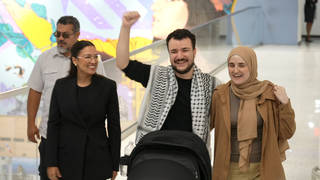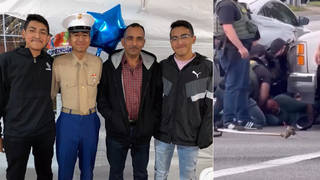
As the Senate begins its debate on the immigration reform bill, we speak to Shena Gutierrez, whose husband was nearly killed in an encounter with Border Patrol agents. While still unconscious in the hospital, he was threatened with deportation. She explains what happened. We also speak with Andrea Guerrero, co-chair of Southern Border Communities Coalition and executive director of Alliance San Diego.
See our related immigration and border patrol coverage.
Transcript
AMY GOODMAN: This is Democracy Now!, democracynow.org, The War and Peace Report. I’m Amy Goodman. As the immigration reform bill makes its way through the mark-up process in the House and Senate, we turn now to the growing push to add harsher border security measures in order for the bill to pass. This week a key member of the so-called bipartisan Gang of Eight working on the bill, Republican Senator Marco Rubio of Florida, said he himself may vote against the bill unless it includes an amendment that calls for full control of the border and 90 percent apprehension of illegal border crossings before immigrants can apply for legal status. The amendment would also require what it calls “situational awareness” of each one-mile segment of the southern border.
For more, we turn to two people working to introduce measures that protect human rights and civil liberties and to the bill, as well. Andrea Guerrero is the co-chair of Southern Border Communities Coalition and executive director of Alliance San Diego. Joining her is Shena Gutierrez, volunteer with Southern [Border Communities] Coalition. She has a very personal experience related to the border: her husband nearly killed in an encounter with Border Patrol agents. While still unconscious in the hospital, he was threatened with deportation. Andrea and Shena live in California but join us from Washington, D.C., where they’ve been meeting with members of Congress.
Let’s go to Andrea Guerrero. If you can talk for a moment about what the so-called Gang of Eight immigration reform bill is and what you are calling for?
ANDREA GUERRERO: Certainly, Amy. The Gang of Eight in the Senate introduced a comprehensive immigration reform bill that includes a Title I that is all about border enforcement. Overall, we think that the bill is, on balance, a good bill. We think that the Title I that treats—deals with border enforcement is, overall, a good title. And we have been working to improve that title. In the mark-up process, we were able to advance some significant amendments that improve the quality of life in the border region, protect the civil liberties of those living in the border region. We are concerned that the rhetoric around the border continues to dominate the conversation around immigration reform. And many who speak of the border have never been to the border or don’t know anyone from the border. So we are here in Washington, D.C., to carry a message of what the border is like. It’s not a barren wasteland. There are 15 million people living in the border region. We have lives. We have businesses. We have families. And we want to make sure that Border Patrol, which has become the largest law enforcement agency in the country concentrated in the border region, is respecting our civil liberties, our civil rights and those of those who are crossing into the country.
AMY GOODMAN: Shena Gutierrez, can you tell us what happened to your husband?
SHENA GUTIERREZ: Sure. Two years ago, March 30th—he was deported to Mexico March 21st. And, you know, he was desperate. You know, we have two young children. At the time, our son was two and a half; our daughter was only four months old. And our daughter was in the hospital. And he was deported, and he was just trying to figure out how to get back to us. March 30th, he attempted to cross back, and I lost contact with him that day. Wednesday, Thursday, Friday go by. By Saturday, I’m completely going insane, not knowing what happened, where he’s at, if he’s alive, if he’s OK. I mean, it just wasn’t like him to not call me and let me know what was going on.
I get a call from the consulate in Arizona asking me, you know, “Is this Shena, who’s his wife?” I said, “Yes.” And I will never forget those words. She says, “Well, we have to inform you that there’s been an accident.” I had no idea what kind of accident she meant. After numerous phone calls, hours later, I find out he’s in Phoenix, and they tell me he’s unconscious. I get to the hospital, and in my mind I’m thinking, you know, “Unconscious: He’s laying in a bed with maybe an IV in his arm, and that’s it, at the most.” And when I turn the corner and I see the two agents—because he was being protected, 24 hours a day, seven days a week, by agents at the door—they stand up, and I notice gun on one side and taser on the other side. And I just kind of peek into his room, and I fall, because he had staples ear to ear, black and blue all over his body. He had machines all over him. And he was in a straight-up coma.
I wasn’t told immediately what happened, but eventually I was told that he became combative. And I didn’t believe it. I know my husband. They told me he fell back and hit his head on a rock. Now, by looking at him, black and blue and staples—and five parts of his skull were removed. But it was brain—his brain was so swollen from the hemorrhaging. I just knew it was not from a fall to a rock. Border Patrol changed their story with me three times. They gave me three different versions of what had happened. They—it just kept changing and changing. So I started calling, you know, all these organizations and media and trying to get some kind of help. I didn’t know what to do, really. I didn’t know. Their—the hospital started telling me, “We’re going to deport him.” He was in a coma. He was on life support. And I said, “You can’t do this to him. This happened here. This needs to be taken care of here.” I don’t even know what’s really going on. I never got a report. I never got any answers. I never got anything. It was hear—you know, he said, she said, that type of thing.
So, we almost lost him a few times. He was in a coma for four weeks. And it was so difficult, so difficult, because I—you know, I’m away from my children for a whole month, and I’m trying to deal with the hospital. My husband’s almost dying, and they want to deport him. And hospital’s blaming Border Patrol; Border Patrol’s blaming them. And finally, he got, after two weeks, a—he got granted a stay from the Ninth Circuit. And they told me, “We’re going to deport him anyways.” And so, here’s my proof. I’m showing them he can stay. He can stay here. You know, I’m excited about it. But they’re saying, “No.” They told me, “He’s illegal. He’s a criminal. He has no room to be here. He can’t pay his medical bills. He needs to go. He’s a criminal.” That’s all they kept telling me. “He’s a criminal. He’s a criminal.” So, he, all the while, is still in a coma. And, thank God, you know, they stopped it. He was able to stay. The agents were gone, finally, from the door, because he was being protected 24 hours a day. And, I mean, after three weeks, he started waking up from the coma. But there was a lot of complications with his trach tube, so they had to put him back into a medically induced coma, off and on.
Finally, he wakes up, and I’m able to bring him back to Los Angeles with me, which is—was the whole plan, to get him out of Arizona. They wanted him out, but they kept telling me, “He can’t go home. He needs to go to Mexico.” Finally, I brought him home, and, you know, it was rough. It was three months in a hospital. Finally, the swelling started coming down from his brain, and he had indentions in his head. I mean, it was just skin on brain. That’s it. It was horrifying. It was horrifying to see that. They did this to him. He went from being perfectly healthy—never been hospitalized, never even had the flu—to your head, your skull is missing, and seizures are happening, and all these complications, pneumonia. And it was—it was very scary, very, very scary.
AMY GOODMAN: And—
SHENA GUTIERREZ: And—mm-hmm?
AMY GOODMAN: What happened then?
SHENA GUTIERREZ: Well, once we got back to Los Angeles, he had to go through rehab. When he woke up from the coma, he couldn’t walk, he couldn’t talk, he couldn’t move. I thought he was paralyzed. He started slowly moving, you know, parts of his body, his hands and whatnot. And they started basically doing rehab with him, getting him to take a few steps. He had trauma to his knee. Once he started talking, about six weeks after he woke from the coma, he started saying, “My knee hurts. It’s killing me. It’s killing me.” And finally, after doing tests and MRIs, they found a lot of blood clots in his knee. And they said it was blunt trauma.
I don’t know how. Border Patrol never gave me answers as to what happened. All they kept saying was, “Your husband was combative. He fell on a rock.” He fell backwards first; then they said he fell forward. They told me, you know, they took him into an interrogation room. So I don’t know what happened in that interrogation room or in second inspection or any other story they told me. I don’t know what happened. And it’s been over two years now, and to date, we don’t have an answer as to what really happened. But we’re left with a lot of questions. How did the—you know, this happen? Why did it happen? Who did this to him?
AMY GOODMAN: Shena, you had to deal with this at the same time—I mean, the reason your husband was trying to come back in so quickly over the border was because your four-month-old daughter was in the hospital with kidney problems. How were you dealing with her through dealing with your husband, who had been beaten so badly?
SHENA GUTIERREZ: I was kind of on survival mode. I don’t know how I dealt with it. I just knew that I had to deal with it. While I was tending to Jose in Phoenix, my family was taking care of my children. My daughter was in the hospital. They were taking care of her. All the while, while in the midst of all this, not only is my daughter in the hospital, our son got diagnosed, in the midst of everything in Phoenix, while I’m with Jose while he’s in a coma, he got diagnosed with autism. So I got that diagnosis while I was out there, so it was just so many emotions, so many thoughts going through my head. And I kind of felt numb. I had to make myself numb, in a way, because I was like, “I can’t let anything bring me down. I can’t let anything tear me down. I need to, like I said, be on survival mode for Jose, for my daughter Aleah, for my son Elijah.” Then, two months—and, again, Jose is still in the hospital recuperating—two months later, my son developed a seizure disorder. So my son’s—and it wasn’t just a seizure disorder; it was epilepsy. They were constantly uncontrollable seizures. I don’t know if it was related to the autism. I don’t know. But I—it was just so much going on, and I didn’t know what to do. But I had a—I have a very, very supportive family, who just kind of were holding me up. They were my backbone to everything that was going on.
AMY GOODMAN: And he—
SHENA GUTIERREZ: I had so many people.
AMY GOODMAN: You are together now in this country. Was your immigration status an issue through this time?
SHENA GUTIERREZ: Yes, it was, because—well, he got—once he got the temporary stay from the Ninth Circuit, a humanitarian visa, medical purposes and whatnot, it was only—it was good for a year. So it expired May of 2012. And again, that leaves me with the constant worry of what’s going to happen. Can something happen? Will they pick him up in the middle of the night? I’m just constantly going through the—you know, it’s just in my head constantly that he can still be picked up.
AMY GOODMAN: So let me ask Andrea Guerrero, how typical is Shena’s story?
ANDREA GUERRERO: Well, Amy, unfortunately, this is a story that we hear about every other month. And we hear about somebody being killed by Border Patrol or seriously injured. And it’s important to note that this is happening to U.S. citizens, as well as to immigrants. Of the 20 cases of those killed that we’ve tracked in the last two years, one-third are U.S. citizens. One-third are also teenagers. They are minors who were throwing rocks at agents, allegedly. And so, we are deeply concerned about what has been a trend in this agency, certainly since the—since the inception of the Department of Homeland Security, but really, this is a trend that predates the DHS formation.
And, you know, in the 100-year history of Border Patrol, rarely, if ever, has an agent been brought to justice for something that they’ve done in the community. And we’re very concerned about that. So we’ve turned to the justice system. We’ve sought justice there for the more than 20 families now whose lives have been changed forever by Border Patrol use of force or excessive use of force. And now we’re going to Congress, and we’re asking Congress to take matters into their own hands, exercise the oversight authority that they have over this agency and provide a very concrete way for us to know what those agents are doing. And that’s to use lapel cameras. And, you know, those are cameras that are placed on the agent’s uniform and which records their interactions with the public every day. This is a technology that’s used by police departments throughout the country. Within two years, we anticipate that all police departments will have such technology. They already use cameras on their vehicles, and they use it in specific settings, right? And so, we know this works. We know that in a police department near where we live, in Rialto, California, that when agents started wearing cameras, that the allegations of abuse dropped by 88 percent. And we also know that agents or officers that wore cameras were engaged in use-of-force incidents half as much as those without cameras. So it has a deterrence effect. It protects officers against false allegations. And, in general, it brings us transparency and openness to officers that are charged with protecting us, protecting the public welfare, making sure that they’re doing their job, that they’re not beating up people, that they’re not, you know, engaged in sexual assaults or stalking of women, which is, you know, something that’s happened recently in another part of California. You know, so, we need to make sure that the investment that Congress is about to make in enhanced border enforcement is—comes with some very meaningful and effective oversight and accountability. And, you know, while like a hearing is an effective way of getting a sense of what’s going on in the agency every couple of months, what we need is a day-to-day oversight mechanism. If lapel cameras work for police, we think that they will work for Border Patrol.
AMY GOODMAN: Let me ask you about Marco Rubio, the senator from Florida, and his saying he himself may vote against the bill unless it includes an amendment that calls for full control of the border and 90 percent apprehension of those who are engaged in illegal border crossings, before immigrants can apply for legal status. Andrea, talk about—what is your response to this?
ANDREA GUERRERO: Well, look, I think that, you know, in order for reform to be comprehensive, we have to address all parts of the broken system at the same time; otherwise, you know, if you—if you fix one leg of the stool and you don’t fix the other, you’re still not going to be able to sit down. We need to be able to move forward as a country on this issue. We need to be able to protect families, keep them together and fill labor needs. And we’re not going to be able to do that if we are only fixing one leg of the stool.
In terms of, you know, enhanced border enforcement, the bill already provides sufficient—we believe, sufficient enhancements to border enforcement in such a way that allows us to move forward with a pathway to citizenship for the 11 million undocumented and protects the rights of border residents, because border enforcement—everyone has to remember that border enforcement in our communities affects not only those who would cross our border, but it affects the 15 million people who are living there who are subject to the roving patrols in our neighborhoods, agents standing outside of our churches, our schools and our grocery stores, asking us for papers, biking down our alleyways while we’re taking out the trash, asking us for papers. I mean, this is a—what we consider a police state in the United States of America, where, you know, I myself recently was on a train to Los Angeles, 100 miles away from the border, and an agent boarded that train. I was alone, single and on that train at 6:00 a.m. in the morning, and that agent cornered me and asked me for my papers. I was terrified. And guess what? I wasn’t carrying any proof of my citizenship. And who would be? So it was my word on whether I was a citizen or not, and it was up to the agent to determine what to do with me. I’m fair-skinned. I speak English without an accent. So he let me pass. But what if I didn’t? You know, I know all too well, in the case of many others, who get wrapped up in the enforcement scheme by Border Patrol, which has extraordinary authority, which overruns our border community.
We do not need any more border enforcement than what we have. We already have operational control in most sectors of the border. Where we don’t, there are mechanisms in the immigration reform bill that’s been proposed that would address those. We would not ask a police department to ensure that we have 90 percent operation control of crime before we would allow children to go to school, before we would allow people to go to work, to earn a living, before we would allow a mother to come home to be with her children. We wouldn’t do that. In the immigration context, we cannot continue to separate families and leave employment gaps unfilled, while we’re trying to address, you know, an enforcement issue at the border. We need to do all things at the same time.
AMY GOODMAN: I want to turn to the case of Anastasio Hernández Rojas. In May 2010—I’m going to just take that again—I want to turn to the case of Anastasio Hernández Rojas. In May 2010, he was caught trying to enter the United States from Mexico near San Diego. He had previously lived in the United States for 25 years, from the age of 15. He was the father of five U.S.-born children. But instead of deportation, Hernández Rojas’s detention ended in his death. A number of officers were seen beating him before one tasered him at least five times. During the attack, Hernández Rojas was handcuffed and hogtied. He died shortly after. The agents say they confronted him because he became—sorry, the agents say they confronted him because he became hostile and resisted arrest. But video recorded by eyewitnesses on their cellphones was released later and showed a very different story. The footage was obtained by reporter John Carlos Frey and appeared PBS last year.
ANASTASIO HERNÁNDEZ ROJAS: [translated] Please! Señores, help me!
JOHN LARSON: What U.S. border agents did not realize is that eyewitness videos of the incident caught the sounds of Hernández Rojas screaming and pleading for his life.
ANASTASIO HERNÁNDEZ ROJAS: [translated] No! Help!
JOHN LARSON: And now, a never-before-seen eyewitness video of the incident raises new disturbing questions. The dark video reveals more than a dozen U.S. border agents standing over Hernández Rojas. It shows the firing of the taser. Was Hernández Rojas, as the police press release suggested, combative when he was killed? Or was he on the ground, handcuffed?
AMY GOODMAN: That was PBS Need to Know reporter John Larson. Democracy Now! spoke to Hernández Rojas’s widow, María Puga, last April. She talked about her family’s response to his sudden death.
MARÍA PUGA: [translated] It has been very painful for all of us, for his brothers, his parents, for me. But perhaps the ones who are suffering the most right now are our children. My kids ask me all the time, “Why did they kill my daddy? What happened to my daddy?” And it’s a question that I, myself, have no answers to, because I don’t know why they did this to him. It’s clear now that they beat him severely on that video.
AMY GOODMAN: That was María Puga. She is the widow of Anastasio Hernández Rojas, speaking about what happened to her husband. I assume both of you know this story well. Andrea Guerrero, how would what you’re calling for in legislation prevent this from happening again, this horror, which was of course denied? And then, only when the video and cellphone footage is there, does another explanation come out.
ANDREA GUERRERO: Well, a lapel camera on an agent would prevent this kind of deceit by the agency to the public. It would let us know right away what happened. But for the eyewitness video that came out two years after the incident, we wouldn’t know what had actually happened, or we wouldn’t be able to corroborate it. So, in the case of Jose Gutierrez, in the case of Anastasio Hernández Rojas and in the case of the 18 others that we’ve been tracking, we would know what has happened. We have needed to rely on eyewitnesses who carry recording equipment themselves. But that’s not the role of the public. That shouldn’t be our role. Our role should be to trust that our tax dollars are funding an agency that is acting responsibly and not with impunity. You know, we are very lucky, Amy, that the media has been very aggressive in investigating these cases. They’ve been riding alongside of us to seek transparency and openness. And I think, fundamentally, this is about oversight and accountability, but it’s also about government transparency and openness. In the case of Anastasio Hernández Rojas, you know, the court is—excuse me, the border agency, Border Patrol agency, is currently trying to seal the court proceedings and seal the evidence in his case, which is going to trial in August. And it’s, you know, because of media inquiries and because of advocacy organizations that hopefully we’ll be able to keep those open. These are cases of public interest. You know, it’s not only important for the families to understand what happened, but it’s important for the rest of us, for the public to understand what is happening with an agency that, by all measures, is out of control and has never, ever been held accountable for its actions.
AMY GOODMAN: I want to end up with Shena Gutierrez. You have come to Washington. You left your family. What is the response of congressmembers as you lobby them to talk about humanity on the border, to the story of you and your husband, Jose Gutierrez, and what happened to him?
SHENA GUTIERREZ: I think it’s been pretty positive. There’s—actually, after, you know, telling the story over and over and over, there’s been a congressman who’s been trying to help out with trying to get a report from Border Patrol as to what exactly happened on that day. And—
AMY GOODMAN: Have you sued?
SHENA GUTIERREZ: —I’m so grateful. We did file—we did file this year.
AMY GOODMAN: I thank you both for being with us.
SHENA GUTIERREZ: Thank you.
ANDREA GUERRERO: Thank you.
AMY GOODMAN: This is Democracy Now!, democracynow.org, The War and Peace Report. I’m Amy Goodman.













Media Options